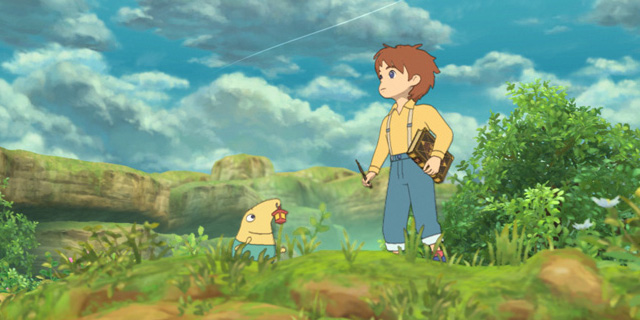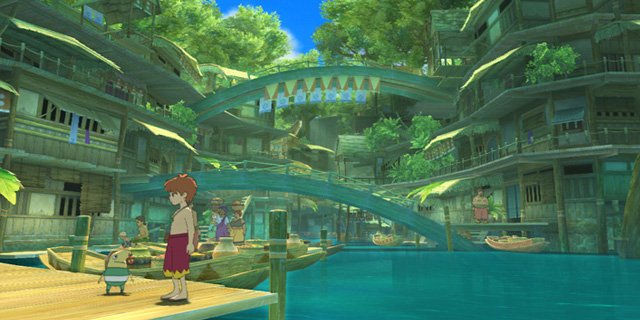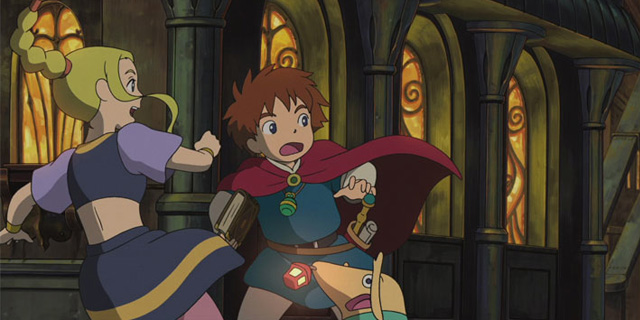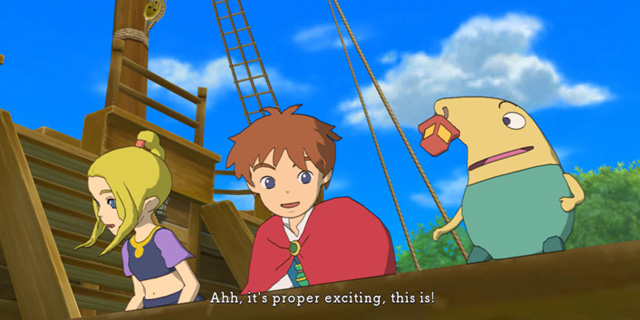Most games try to start out with a bang. It may be an epic battle, or stunning vistas with photorealistic graphics. Ni no Kuni completely disregards that train of thought, and begins with a young boy doing chores to help his mother. This understated, ordinary beginning leads into an adventure unlike any other I’ve experienced in games, and it is all the better for it.
At first glance, Oliver seems like any other young boy in Motorville. He’s helpful and caring, yet excitable and a bit reckless. He and his friend have secretly built their own little car, and have decided to sneak out and test drive it at night. Things don’t quite go as smoothly as expected, however, and Oliver ends up driving into the river and being saved by his mother. Unfortunately, Oliver’s mother suffers from a weak heart, and the exertion and stress overwhelm her.
As any child is wont to do after such a tragedy, while holding a doll his mother gave him, Oliver cries in his room. Of course, this being a Studio Ghibli production, his tears of sadness bring the doll to life, at which time we discover it isn’t really a doll, but the Lord High Lord of the Faeries, cursed by an evil sorcerer. The Lord High Lord, named Drippy, begs Oliver to come save his world and tells him that, in the process, he may be able to save his own mother. Buoyed by that hope, Oliver and Drippy begin their quest.
Through cutscenes, we discover that what makes Oliver so special, and the only one who can defeat Shadar the Dark Djinn, is his pure heart and caring nature. He’s not physically imposing, he’s not strong, he’s not an amazing wizard, he’s simply a boy who’s willing to help anyone and everyone he can.
His determination to do so, and his desire to save his mother, form the basis of the most humble save the world plot we’ve seen in an RPG in a long time. The humble beginnings, and the accompanying tragedy, served to make me care about Oliver’s tale in the best way possible. It made me personally invested in the story, and the way it unfolds over time just enhances that connection.
As with any RPG, the combat is important, and Ni no Kuni draws on a variety of influences to create a system that works extremely well, once you get used to it. Primarily a mix of Final Fantasy XII, the Tales series and Pokemon, combat is largely a real-time affair in a free-moving 3D arena with AI-controlled partners.
Studio Ghibli’s visuals
I can count on one hand the number of games I’ve played where I still marveled at the graphics more than an hour or so into them. Ni no Kuni has joined that list, and may top it before I finish it. Even after dozens of hours, I still sometimes sit and stare unbelievingly at the world. I have no idea how Level-5 managed to take Ghibli’s animation style and overlay it so seamlessly onto a 3D game, but I’m so glad it did.
Fighting takes place in real-time, though when you enter a menu combat pauses to allow you as much time as you need. No button mashing is required for attacking or blocking either, as each character and familiar has their own movement and attack speeds. When no combat options are selected, you can freely move around the battlefield, which is often an important part of your strategy.
You can run away from attacks, go long-range to make spellcasting safer, lead enemies on a chase while your partners attack them unhindered or even try to outmanuever bosses to find weakspots such as their tail. Additionally, glowing orbs called glims will often appear on the field. Grabbing them will restore health, magic, or even in rare instances, fully heal you and give you access to a massively powerful attack.
Each AI can be given its own set of tactics, and, provided they have the right moveset for those tactics, generally do a passable job of assisting with combat. They’ll sometimes do completely stupid things, but there’s not really anything that can be done for that. Luckily, if you lose a battle, whether due to being underleveled, poor strategy or poor AI, there’s not a big penalty. You’ll lose 10% of your money and go back to where you entered the area to try again.
As for the Pokemon connection, most of the fighting in Ni no Kuni will be done with familiars. Familiars are little monsters who are friendly to you, either out of their very nature or because you convinced them to join you by beating them up on battle. These guys level up just as Oliver and his companions do, they learn new skills as they level up, and they can be equipped with a wide variety of weapons, armors and accessories. Finally, you can feed them treats to enhance their stats, and there are even some treats that will help them undergo metamorphosis into stronger forms when they reach certain levels of growth.
When not doing battle, Oliver and company often find themselves helping out random denizens with any number of problems. Maybe they need help clearing out some monsters for security, maybe they lost an item of some kind, or more commonly, maybe Shadar broke their hearts.
One of the central mechanics of Ni no Kuni is the idea that people get brokenhearted, and only a wizard such as Oliver is able to do anything to help them. A brokenhearted person has had a little part of their essence stolen, whether it be some of their enthusiasm, kindness, even courage or love. In order to help someone like that, Oliver must find someone who has that attribute in abundance and ask permission to take some from them. He is then able to use his magic to siphon it off into a phial and give it to a heartbroken person.
Level-5 localization
Localization is always a tricky thing, even now. That’s why it’s so refreshing to see Richard Honeywood and Level-5 take the spirit of the script in Ni no Kuni and be willing to fully explore the fun ways to use the world to play with it. Sure, every once in awhile, one of the many, many puns feels forced, but for every one of those, you’ve got a cat king called His Meowjesty, a crow talking about being raven mad and a desert oasis with milk springs run by a Cowlipha. It runs the gamut from clever to just silly, and I loved every moment of it.
Sometimes this is essential to advance the plot, but most often it is a side quest. Doing side quests will earn you rewards and merit points, which can be used to purchase abilities of varying usefulness, from pointless but fun jumping on the world map to increased glim creation or even improved familiar recruitment. Bounty hunts are also available, and these usually pit you against slightly stronger versions of normal enemies.
You’ll also eventually gain the ability to create items using an alchemy pot, which is a great and powerful feature, since it enables you to create more powerful items, weapons and armor than you can purchase, but it’s implementation can be a bit of a pain at times. You can either choose to experiment or go by a recipe, as usual, but when an experiment creates a useful object, you’ll have to remember what you did. Only recipes you’ve been given by NPCs get recorded in the recipe list.
Of course, it’s impossible to talk about Ni no Kuni at all without mentioning its graphics or localization. Studio Ghibli did the graphics, so it was a given that the cutscenes would look amazing, but they succeeded in making every single part of the world of Ni no Kuni look and feel like it belongs in one of their movies. Imagine playing Kiki’s Delivery Service as Kiki, or visiting the world of Howl’s Moving Castle as an interactive and player-driven experience. This is what every moment feels like, to the point that I sometimes just stop playing and marvel at the world.
As for the localization, the voice acting is sometimes hit-or-miss, and Oliver sometimes can’t decide whether to use his British or American accent (I have that trouble myself sometimes), but in general it does a good enough job to draw you in. Where the writing really shines though is in the script. Whether it is giving a character an accent, like Drippy’s Welsh, or simply playing on words, the script is brilliantly localized.
Taken all together, Ni no Kuni is a game that everyone should experience, whether they are usually a fan of RPGs or not. There are a couple of minor annoyances, but this is a world begging to be experienced and explored, and its siren call should not be ignored.
Pros: Great characters, feel-good story, enjoyable combat, wonderfully punny localization
Cons: AI sometimes gets stupid, alchemy isn’t implemented very well
























